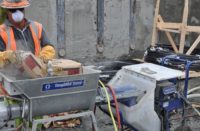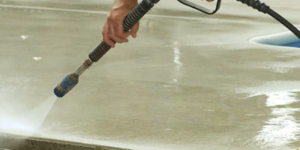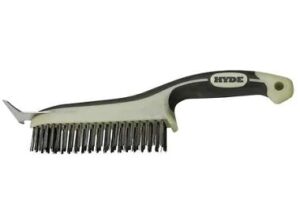 Pressure or power washing has traditionally been used as the standard to clean and maintain exterior hard surfaces or hardscaping. This cleaning process has rendered acceptable results for years because the standard surface to be cleaned was a basic flat concrete finish without color. Concrete design and application has changed drastically. Modern decorative concrete surfaces are beautiful and rich in design, color and finish. They also represent a significant investment for the owner. This calls for revisiting how to properly clean and maintain many modern hard surfaces without causing damage.
Pressure or power washing has traditionally been used as the standard to clean and maintain exterior hard surfaces or hardscaping. This cleaning process has rendered acceptable results for years because the standard surface to be cleaned was a basic flat concrete finish without color. Concrete design and application has changed drastically. Modern decorative concrete surfaces are beautiful and rich in design, color and finish. They also represent a significant investment for the owner. This calls for revisiting how to properly clean and maintain many modern hard surfaces without causing damage.
The desired finish for most modern concrete is attained by working the surface to bring up the “cream” consisting of cement and fine aggregate as well as color. The result is a hard, smooth and rich finish. Using pressure washing machines to clean concrete generally results in a tremendous amount of pressure being used at very close range. This usually results in a marked improvement in the overall appearance of the surface. Unfortunately, this can also tear into the fine finish of the concrete, especially after a high-pressure treatment or multiple cleanings.
This often results in revealing the fine aggregate (generally sand) beneath the surface and partially or almost completely removing the finish, including the color. This damage can’t be undone without installing an overlay because the newly exposed aggregate won’t retain a restain or dye. It is compounded by the fact that the surface is now far more porous and prone to unwanted staining. The new color is a dull tone that reflects the color of the revealed aggregate.
Power washing has been and will continue to be a valuable tool for professional contract cleaners. That said, an experienced power washing contractor knows there’s a real art to achieving acceptable results using the proper tools. Unfortunately, countless results show that pressure washing is the culprit for a very large percentage of damage caused to many hard surfaces.
Typically when a pressure washing wand is used, keeping a consistent distance from the surface is ergonomically challenging. Using a surface cleaner greatly improves this problem for field areas. However, surface cleaners are designed to be used with spray tips generally 1 to 2 inches from the surface. In many cases, this is too close to safely clean without causing damage to costly, fine hard surfaces.
The facts show that professional surface cleaners can and do “cut” into the finished concrete surface, and the circular rings of damage are unmistakable. While power washing will always have a place in exterior cleaning, many modern materials and surfaces dictate that it should be used as an effective rinsing tool from 1 foot or more away from the surface, not a couple of inches.
Other hard surfaces, such as stone, can be severely damaged using pressure. Many hardscapes use softer stones, such as sandstone and flagstone, which obviously need to be handled delicately. Sedimentary stone such as slate, flagstone and limestone can have a relatively high resistance to direct vertical pressure but are highly prone to delamination and can be severely damaged by pressure washing.
Today, modern decorative concrete and hardscaping can be safely and effectively restored using little or no pressure and the results attained are far superior. Advances in environmentally safe, incredibly effective chemicals, as well as professional application methods, allow experienced professionals to remove all sorts of stains including biological staining, rust, battery acid, fertilizer, efflorescence, grease, oil and dirt. The stunning results provide a more comprehensive clean that lasts far longer and doesn’t damage modern hardscape surfaces.















